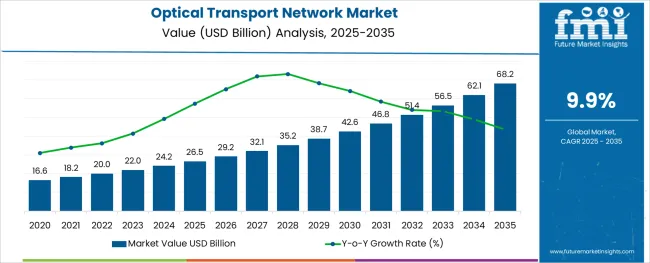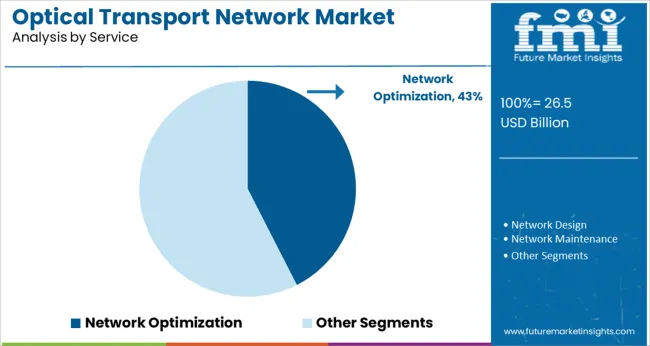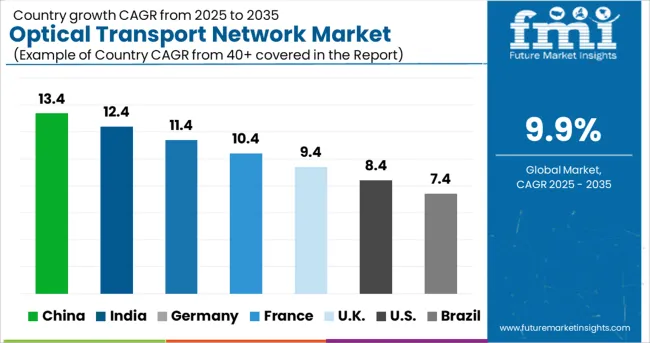The Optical Transport Network Market is estimated to be valued at USD 26.5 billion in 2025 and is projected to reach USD 68.2 billion by 2035, registering a compound annual growth rate (CAGR) of 9.9% over the forecast period.

The optical transport network market is experiencing steady growth driven by the increasing demand for high-capacity data transmission and network scalability. Growing internet traffic and the expansion of cloud services have accelerated the need for robust transport technologies that can support large volumes of data with low latency.
Advances in optical communication technologies have enhanced the efficiency and reliability of long-distance data transmission. Service providers are focusing on upgrading infrastructure to meet the demands of 5G, data centers, and enterprise connectivity.
Additionally, cost optimization and network performance improvements remain top priorities in network management. Future growth is expected to be propelled by innovations in wavelength division multiplexing and software-defined networking. Segment growth is expected to be led by DWDM technology, optical transport components, and network optimization services as key drivers of market expansion.
The market is segmented by Technology, Component, Service, and End-User Application and region. By Technology, the market is divided into DWDM and WDM. In terms of Component, the market is classified into Optical Transport, Optical Packet Platform, and Optical Switch. Based on Service, the market is segmented into Network Optimization, Network Design, Network Maintenance, and Other Support Services. By End-User Application, the market is divided into Communication Service Providers, Communication Network Operators, Enterprises and Organization, and Government and Institution. Regionally, the market is classified into North America, Latin America, Western Europe, Eastern Europe, Balkan & Baltic Countries, Russia & Belarus, Central Asia, East Asia, South Asia & Pacific, and the Middle East & Africa.

The DWDM technology segment is projected to hold 49.7% of the optical transport network market revenue in 2025, making it the leading technology type. This segment’s growth has been driven by the ability of DWDM to significantly increase bandwidth by multiplexing multiple wavelengths on a single fiber.
Its application allows service providers to efficiently meet escalating data traffic demands without laying additional fiber infrastructure. DWDM systems support long-haul and metro networks, offering scalability and flexibility to network operators.
The rising adoption of 5G networks and cloud computing has further increased the reliance on DWDM to handle high-speed data transfer. As network capacity demands continue to surge, DWDM technology is expected to retain its leadership position.
The optical transport component segment is expected to contribute 40.7% of the market revenue in 2025, holding the dominant share among components. Optical transport systems form the backbone of data transmission networks, providing the essential hardware for signal routing, switching, and amplification.
Demand for high-quality optical transport components has grown alongside the expansion of fiber optic networks worldwide. Improvements in component reliability and energy efficiency have supported wider adoption across diverse network environments.
These components are critical for ensuring low latency and high throughput, which are essential for emerging applications such as video streaming, virtual reality, and cloud services. The optical transport segment is expected to maintain its prominence due to ongoing infrastructure upgrades and expanding network footprints.

The network optimization service segment is projected to hold 42.5% of the optical transport network market revenue in 2025, securing its place as the leading service offering. Growth in this segment is fueled by the increasing complexity of managing large-scale optical networks and the need to maximize performance while controlling costs.
Network optimization services help operators enhance bandwidth utilization, improve fault detection and recovery, and reduce operational expenses. The integration of advanced analytics and software-defined networking has allowed service providers to automate and fine-tune network operations.
As demand for reliable and efficient network performance rises, the importance of network optimization services is becoming more pronounced. This segment is expected to continue driving service-related market growth.
With increasing technologies, telecom industries are one of them, which is rising the demand for optical transport network due to increasing IoT and smartphones in the coming forecast period from 2025 to 2035.
The network is quiet enough to provide all the requirements, including data, voice, video and other necessary things related to customers. Such innovations to fulfil the transport network is anticipated to grow the optical transport network market trends.
Although optical transport network forwards a piece of clean and clear information to the telecom industries as it is one of the better networks of transporting important information, which is likely to enlarge the sales of optical transport network in coming years.
The optical transport network market's key trends & opportunities are anticipated to increase as it offers various benefits. Some of them are management, monitoring, and flexibility. It also improved the reliability and secured all the services efficiently as per the optical transport network market survey.
Apart, the optical transport network also restrained the optical transport network growth due to a lack of awareness related to the optical transport network, high costs, and disconnection of the network, which drive the possibility of the decline of optical transport network market future trends in the forecast period from 2025 to 2035.

North America dominates the optical transport network market share by acquiring 38.1% of the share in the optical transport network all around the globe during the forecast period from 2025 to 2035.
Due to rising IoT and an online presence worldwide, the optical transport network market trends & forecasts also like to rise in the North America region, acquiring the lion’s share as per optical transport network market statistics.
The Europe region placed second in the optical transport network market size by acquiring 25.6% of the share of optical transport network equipment market share during the forecast period from 2025 to 2035.
Increasing IoT is the main factor of rising in the production of the optical transport network in the region. The rapidly demand optical transport network by end-users is growing the adoption of Europe optical transport network in the coming forecast period from 2025 to 2035.
The key industries are likely to upsurge the optical transport network market future trends during the forecast period. Boosting the high speed of broadband is the key factor in the growing adoption of the optical transport network market.
Recently, the telecom company Vodafone Idea Ltd came with their new deploy 5th generation coherent optical service to their customers from Ciena in January 2025.
ZTE corporation launched the new compact metro edge ON product which include 4G/5G, cloud, broadband services with large capacity and also a cross-connection technology in a compact size.
These trends and recent launches are likely to develop the optical transport network size in the coming period.

The major player operating in the optical transport network market includes ADVA Optical Networking, Aliathon Technology, Ciena Corporation, Fujitsu, Infinera Corporation, Huawei Technologies Co., ZTE Corporation, ADTRAN, Ericsson, Cisco, Alcatel- Lucent, ECI Telecom Ltd., and Coriant.
All these key industry players are rising to boost the optical transport network market future trends by adopting innovative ideas and methodologies.
| Report Attribute | Details |
|---|---|
| Growth Rate | CAGR of 9.9% from 2025 to 2035 |
| Base Year for Estimation | 2024 |
| Historical Data | 2020 to 2024 |
| Forecast Period | 2025 to 2035 |
| Quantitative Units | Revenue in million and CAGR from 2025 to 2035 |
| Report Coverage | Revenue Forecast, Volume Forecast, Company Ranking, Competitive Landscape, Growth Factors, Trends and Pricing Analysis |
| Segments Covered | Technology, End User, Region |
| Regions Covered | North America; Latin America; Europe; East Asia; South Asia; Oceania; Middle East and Africa |
| Key Countries Profiled | USA, Canada, Brazil, Argentina, Germany, UK, France, Spain, Italy, Nordics, BENELUX, Australia & New Zealand, China, India, ASEAN, GCC, South Africa |
| Key Companies Profiled | Ciena Corporation; Cisco; Coriant; FUJITSU; Huawei Technologies Co. Ltd; Infinera Corporation; Nokia; ZTE Corporation |
| Customization | Available Upon Request |
The global optical transport network market is estimated to be valued at USD 26.5 billion in 2025.
It is projected to reach USD 68.2 billion by 2035.
The market is expected to grow at a 9.9% CAGR between 2025 and 2035.
The key product types are dwdm and wdm.
optical transport segment is expected to dominate with a 46.3% industry share in 2025.






Full Research Suite comprises of:
Market outlook & trends analysis
Interviews & case studies
Strategic recommendations
Vendor profiles & capabilities analysis
5-year forecasts
8 regions and 60+ country-level data splits
Market segment data splits
12 months of continuous data updates
DELIVERED AS:
PDF EXCEL ONLINE
Optical Transport Network Equipment Market Size and Share Forecast Outlook 2025 to 2035
Optical Spectrum Analyzer Market Size and Share Forecast Outlook 2025 to 2035
Optical Extinction Analyzer Market Size and Share Forecast Outlook 2025 to 2035
Optical Character Recognition Market Forecast and Outlook 2025 to 2035
Optical Satellite Market Size and Share Forecast Outlook 2025 to 2035
Optical Imaging Market Size and Share Forecast Outlook 2025 to 2035
Optical Whitening Agents Market Size and Share Forecast Outlook 2025 to 2035
Optical Fingerprint Collector Market Size and Share Forecast Outlook 2025 to 2035
Optical Lens Materials Market Size and Share Forecast Outlook 2025 to 2035
Optical Microscope Market Size and Share Forecast Outlook 2025 to 2035
Optical Component Tester Market Size and Share Forecast Outlook 2025 to 2035
Optical EMI Shielding Adapters Market Size and Share Forecast Outlook 2025 to 2035
Optical Connector Polishing Films Market Size and Share Forecast Outlook 2025 to 2035
Optical Transmitter Market Size and Share Forecast Outlook 2025 to 2035
Optical Telephoto Lens Market Size and Share Forecast Outlook 2025 to 2035
Optical Lattice Clock Market Size and Share Forecast Outlook 2025 to 2035
Optical Grade Lithium Tantalate Wafers Market Size and Share Forecast Outlook 2025 to 2035
Optical Grade LiTaO3 Crystal Substrate Market Size and Share Forecast Outlook 2025 to 2035
Optical Brighteners Market Size and Share Forecast Outlook 2025 to 2035
Optical Liquid Level Sensor Market Size and Share Forecast Outlook 2025 to 2035

Thank you!
You will receive an email from our Business Development Manager. Please be sure to check your SPAM/JUNK folder too.
Chat With
MaRIA